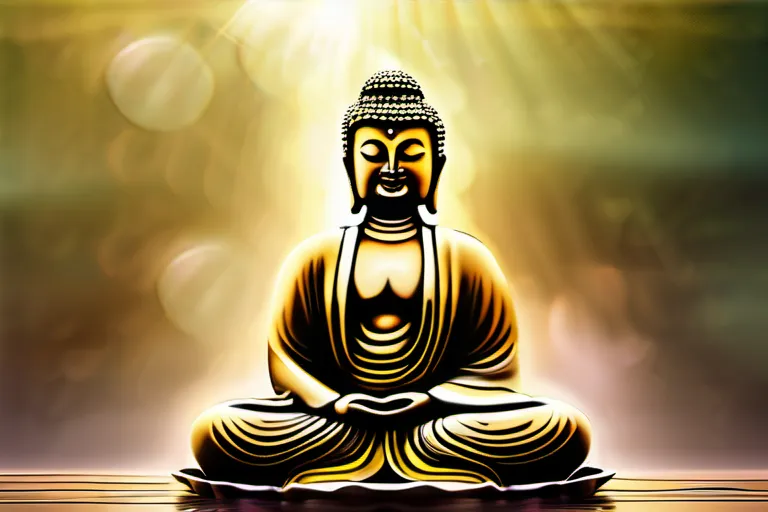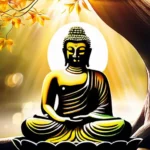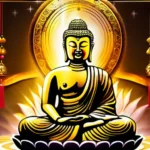Explore the essence of the Middle Way, the heart of Buddhist philosophy.
The Middle Way is a fundamental concept in Buddhism that represents a balanced path to enlightenment. This article delves into its origins, principles, and significance in Buddhist teachings.
The Origin and Significance of the Middle Way
The Middle Way, a term steeped in mystery and significance, first emerged from the profound journey of Gautama Buddha. Imagine, if you will, a traveler wandering through a dense forest where paths diverge endlessly. One path leads to luxury, another to poverty. Both seem appealing but both are fraught with their own dangers. The Middle Way is that narrow trail that offers balance and freedom from extremes.
According to legend, after the Buddha attained enlightenment under the Bodhi tree, he pondered whether to share his knowledge or keep it secret. He quickly realized that either path—burying himself in luxury or retreating into extreme asceticism—would hinder his ability to teach others. The Middle Way offered a balanced approach, where he could lead by example without compromising his spiritual purity.
Historically, the Middle Way was first introduced as a response to these extremes of life. It wasn’t just about finding a comfortable path but one that led to true understanding and liberation from suffering. By adopting this way, the Buddha aimed to strike a balance between indulgence and austerity, advocating for a moderate lifestyle where wisdom guides every action.
The significance of the Middle Way in Buddhist teachings lies in its emphasis on practicality over theoretical extremes. It’s like choosing a path that avoids the pitfalls of quicksand (luxury) or treacherous cliffs (poverty), leading to a steady journey toward enlightenment.
But why is this way so crucial? Isn’t it about finding joy and happiness, not just liberation from suffering? Indeed, but true joy comes from a life lived in moderation. The Middle Way teaches us that neither extreme nor indulgence can provide lasting contentment; only balance can guide us to profound peace.
So, as we delve deeper into the teachings of Buddhism, remember the essence of the Middle Way: it’s not about giving up but finding a way through life’s complexities with grace and wisdom. It’s the art of living well without excess or deficiency, leading to a fulfilling path towards enlightenment.
The Four Noble Truths and the Eightfold Path
The Four Noble Truths and the Eightfold Path are the heartbeats of Buddhist practice, guiding followers towards enlightenment through understanding and action. But how do these profound teachings connect to the essence of the Middle Way?
Is the Middle Way merely a philosophical concept or does it have practical applications in everyday life? How can we navigate the often complex and contradictory realities of existence with wisdom and balance?
The Four Noble Truths introduce us to the core problems faced by all beings: suffering, its causes, cessation, and the path leading to that cessation. The Eightfold Path is a roadmap for addressing these truths—right understanding, right intention, right speech, right action, right livelihood, right effort, right mindfulness, and right concentration.
Imagine life as a vast sea with waves of joy and sorrow, hope and despair constantly ebbing and flowing. How do we navigate this turbulent ocean without being swept away by its currents?
The Middle Way is not just about avoiding extremes; it’s about finding a balanced path that recognizes the impermanence of all things while embracing the inherent suffering and non-self nature of existence. It’s like walking through a dense forest where every step could be either too light or too heavy—too indulgent in pleasure, or too harsh in asceticism.
By adopting the Middle Way, practitioners can see clearly and act wisely without succumbing to the pitfalls of excess or deficiency. This approach ensures that our actions are grounded in reality, addressing suffering not by ignoring it but by understanding its nature and working towards its cessation through compassionate action.
‘Can you walk this path with equanimity, knowing that every step is a dance between wisdom and compassion?’
The Three Marks of Existence and their Relation to the Middle Way
The three marks of existence—Anicca, Dukkha, and Anatta—are like the pillars that support the structure of Buddhist philosophy, and they provide a profound insight into the nature of reality. How do these marks illustrate the essence of the Middle Way?
Is life ever truly stable?
Buddhism teaches us that everything in the universe is Anicca, or impermanent, much like a river that flows and changes constantly. Just as you cannot step into the same river twice, nothing remains the same for long. This concept challenges our notion of fixed identities and stable realities, urging us to see things as they truly are: in constant flux. The Middle Way recognizes this impermanence without falling into the extremes of attachment or aversion.
- How do we navigate through a world that is always changing?
The second mark, Dukkha, or suffering, is intrinsic to life. It’s like carrying an imperceptible weight, one that is hard to shake off completely. Suffering can be found in the ups and downs of daily life, from small inconveniences to deeper emotional pain. The Middle Way does not deny this reality but seeks a path that minimizes suffering through balance and moderation.
- Can we truly find peace amidst such inherent challenges?
The third mark, Anatta, or the non-self nature of phenomena, suggests that there is no permanent self or soul. It’s like recognizing that what we perceive as a solid, unchanging entity is merely a collection of temporary elements, much like an illusionary mirage in the desert. The Middle Way acknowledges this to avoid the extremes of ego inflation and self-denial.
Can we truly grasp our true nature without clinging or rejecting?
The interplay of these three marks provides a clear picture of life as it is, marked by impermanence, suffering, and the absence of a permanent self. The Middle Way offers a balanced approach to navigate this complex reality, encouraging us to find contentment in the present moment without being swayed by fleeting desires or deep-seated aversions.
The Role of Mindfulness and Meditation in Practicing the Middle Way
The role of mindfulness and meditation in practicing the Middle Way cannot be overstated. Imagine the Middle Way as a vast, serene lake where you must navigate your thoughts like a gentle breeze across its surface. Mindfulness is akin to standing on the shore, observing without interfering—watching each ripple form and dissipate before your eyes. It’s about being present in the moment, aware of your thoughts and feelings without judgment.
Meditation, then, becomes the tool that helps you dive into the depths of this lake. By sitting quietly and focusing on your breath or a chosen object, you learn to calm the turbulent waters within. This practice allows you to understand the impermanence and suffering inherent in existence, aligning with the essence of the Middle Way.
But why is mindfulness so crucial? Isn’t it just about observing things as they are? Not quite. Mindfulness enables us to recognize our tendencies towards extremes—either indulging in pleasure or retreating into aversion. These habitual patterns can cloud our judgment and lead us astray from the path of balance and wisdom.
Through meditation, we develop the capacity for non-reactivity. Instead of immediately latching onto our thoughts and feelings, we learn to observe them without attachment or aversion. This is where true understanding begins—understanding that our cravings and aversions are not permanent, but fleeting phenomena.
Mindfulness and meditation also help us cultivate metta, or loving-kindness. By extending this practice towards ourselves and others, we break down barriers of self-centeredness and promote compassion. This is a critical aspect of the Middle Way as it emphasizes not only individual liberation but also interconnectedness.
In essence, mindfulness and meditation are the keys that unlock the door to the Middle Way. They provide us with the tools to navigate life’s complexities with grace and wisdom, ensuring we neither succumb to excess nor wallow in negativity. By integrating these practices into our daily lives, we can live more harmoniously, reducing suffering and fostering a deeper connection with ourselves and others.
The Impact of the Middle Way on Buddhist Ethics and Morality
The impact of the Middle Way on Buddhist ethics and morality is profound, much like the gentle flow of a river that shapes the landscape without force. How do we navigate through life’s complexities while avoiding the extremes? The Middle Way offers a balanced path, guiding us towards compassion and ethical living. Can we truly grasp the essence of this ancient teaching in our modern lives?
At its core, the Middle Way emphasizes moderation and reason, urging practitioners to find a harmonious middle ground between sensual indulgence on one extreme and self-mortification on the other. This approach fosters a compassionate lifestyle, where actions are guided by wisdom and understanding rather than mere personal desires or fears.
For example, consider the ethical dilemma of wealth and poverty. The Middle Way teaches us to neither hoard possessions nor live in constant deprivation. Instead, it encourages us to find a balance that allows us to support ourselves and others while minimizing harm to the environment and society. How often do we see individuals who are overly attached to their material gains at the expense of others’ well-being?
The Middle Way also plays a crucial role in resolving conflicts. By advocating for patience, understanding, and non-violence, it provides a framework for peaceful resolution without resorting to aggression or passive withdrawal. Imagine two parties in a heated argument; how would their interactions differ if they approached the situation with the principles of the Middle Way?
Moreover, this path encourages us to live mindfully, being aware of our actions and their consequences. It teaches us that ethical living is not just about following rules but about cultivating inner wisdom and compassion. How can we apply these teachings in everyday life—whether it’s treating others with kindness, protecting the environment, or dealing with personal challenges?
The Middle Way, therefore, shapes a lifestyle characterized by wisdom, compassion, and balance, making our ethical choices more informed and our actions more beneficial for all. It invites us to explore this path deeply, asking us: Can we truly live in harmony with ourselves and the world around us through the practice of the Middle Way?
The Relevance of the Middle Way in Modern Times
The relevance of the Middle Way in modern times cannot be overstated, especially as our societies grapple with unprecedented challenges. How can we navigate through the complexities of technology, climate change, and social inequality? The answer lies within the Middle Way, a path that seeks balance amidst extremes.
Imagine life as a tightrope walker, balancing on a wire between two cliffs—too far to one side, and you fall into despair; too far on the other, and you risk becoming arrogant. The Middle Way is like finding that precarious but crucial point where neither cliff looms so ominously. It’s about living in harmony with oneself and others, not succumbing to extremes of pleasure or pain.
Consider how often we find ourselves torn between two opposing forces: the desire for success at any cost versus the need for sustainable practices; the rush to embrace new technologies without questioning their impact versus clinging to outdated methods. The Middle Way offers a balanced approach—embracing innovation while preserving ethical values, and fostering growth sustainably.
Moreover, in today’s polarized world, where dialogue often devolves into confrontation, the Middle Way serves as a bridge of understanding. It teaches us to listen with empathy and respond thoughtfully, rather than immediately reacting out of anger or frustration. This isn’t about avoiding conflict but navigating it with wisdom and kindness.
The Middle Way is also crucial in our personal lives, helping us manage stress and find contentment. We live in a culture that often equates happiness with constant stimulation and consumption. But the Middle Way reminds us to find joy in simplicity and moments of quiet reflection. It’s about recognizing the value in small pleasures without becoming overly attached.
As we navigate the challenges of modern life, let us embrace the wisdom of the Middle Way. It offers a path that respects all aspects of our being—emotional, intellectual, and spiritual. By walking this balanced path, we can create a more harmonious world for ourselves and future generations.
Conclusion
 By understanding the Middle Way, you’ll gain insights into the Buddhist approach to life and attaining Nirvana.
By understanding the Middle Way, you’ll gain insights into the Buddhist approach to life and attaining Nirvana.











